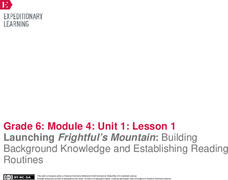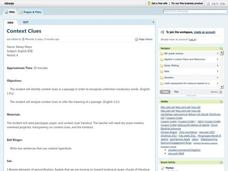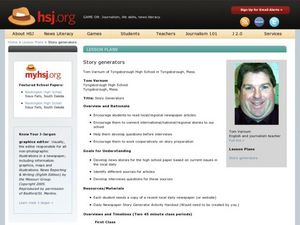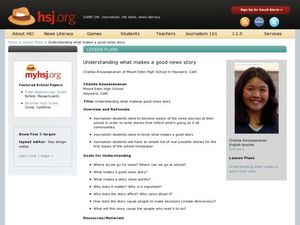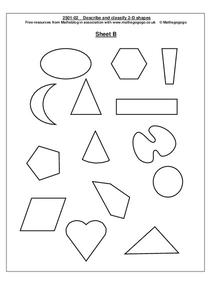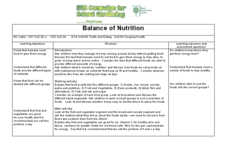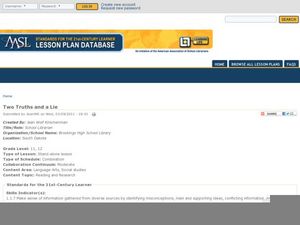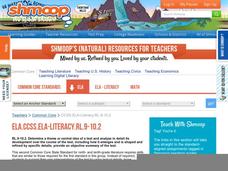EngageNY
Launching Frightful’s Mountain: Building Background Knowledge and Establishing Reading Routines
Welcome to Frightful's Mountain. The teacher introduces scholars to the text Frightful’s Mountain by reading the first chapter aloud. Learners then talk with a partner about the text. The instructor models answering focus questions...
Curated OER
Economy Or Environment: Which Comes First?
Young scholars compile a portfolio of work from a unit on Maine's natural resources and economy. They choose four of their best assignments from the unit then synthesize the ideas in each to write an essay or construct a visual history...
Curated OER
How Do I Write an Article Critique?
Your middle and high schoolers have written tons of summaries, but can they give a strong critique of an article they've read? Identify the differences between summary writing and critiquing. Choose an interesting article and have...
Curated OER
Context Clues
Work on context clues with your ninth graders in this lesson, which focuses on identifying and analyzing clues to define unfamiliar words. They identify context clues in a passage to recognize words they haven't seen before, and then...
Curated OER
Seedfolks
Students explore sequencing. In this sequencing lesson, students sequence events to analyze character actions as cause and effect or the plot of the story. Students discuss character actions and list them on a chart.
Curated OER
Prewriting
As a class, 7th graders observe examples of brainstorming and then complete brainstorming worksheets themselves. They compose and describe planning strategies. Prior to writing an essay, they identify the purpose and the audience.
Curated OER
Pay it Forward
Young scholars explore the basic concept of micro-financing. For this economics/literacy lesson, students listen to One Hen by Katie Smith, in which a small loan changes the life of the main character. Young scholars employ comprehension...
Curated OER
Yesterday's World "th" activities
Students read through the text, and discuss the main points. They discuss the commonality of the digraph/th/. Students highligt any text with 'th'word where they see it. They identify the words. Students discuss the different sounds on...
Curated OER
Story Generators
Young scholars develop news stories for the high school paper based on current issues in the local news. Students identify different sources for articles, and develop interviews questions. In this news ideas and sources lesson plan,...
Curated OER
Narrow It Down
Students participate in a logic activity in which they identify items. In this logic activity, students work in groups as they play a questioning game that is similar to "Twenty Questions." They ask questions and rule out items in a...
Curated OER
Sum It Up!!!
Students main goal of reading is comprehension. They encounter one main strategy of summarization. They comprehend that summarization is the process of finding the most important information from a reading. Students must follow several...
Curated OER
Social Studies: Aztec Calendars and Culture
Sixth graders analyze the Aztec calendar and create their own examples of them. They determine the meaning of the symbols used in the calendars and record their ideas in journals. Students host a parent breakfast for them to observe...
Curated OER
Understanding What Makes a Good News Story
Students explore the news sources at their school in order to write stories that reflect what's going on in all communities and to identify what makes a good story. In this news writing lesson, students journal about what makes a...
Curated OER
Shapes
In this shapes worksheet, students identify shapes according to sentences that describe them. Students identify 8 shapes, but have 14 to choose from.
Curated OER
Roles of the President
Students read a document which explains the roles and responsibilities of the President of the United States. In groups, they tour the George Bush Presidential Museum and participate in a Presidential scavenger hunt. Once back in the...
Curated OER
You've Got to be Taught to Hate and Fear
Students explore themes of prejudice and acceptance. In this character education lesson, students listen and respond to several fiction books, poems, and lyrics with a similar theme. Students locate articles with the main idea of...
Curated OER
Balance of Nutrition
Students explore nutrition by completing a group activity. In this balanced meal lesson, students identify the five food groups and discuss their favorite foods from each group. Students utilize illustrations to fill in a fictional plate...
Curated OER
Figure Analysis
Learners review the elements of design and how they relate to fashion. Individually, the perform a self-analysis on their body type and identify the appropriate clothing type. To end the lesson, they sketch their own clothing ideas...
Curated OER
Identifying and Describing Story Elements
First graders examine how to identify the different elements of a story and how they fit in a definite sequence. The use of comprehension skills is essential to retell the story as desired within the lesson.
Curated OER
Identifying the Relationship Between Black Carbon and the Weather
Young scholars identify the relationship between black carbon and the weather. In this investigative lesson students compare samples of black carbon with a color-scale and analyze others samples.
Curated OER
Two Truths and a Lie: Internet Research Skills
It's tough for high schoolers to assess what is a credible resource and what is not. A helpful resource prompts class members to research a particular topic and record two facts—and create one lie—while documenting the sources. They...
Prestwick House
Rhyme and Repetition in Poe's "Annabel Lee"
Many and many a year ago Edgar Allan Poe crafted the chilling tale of "Annabel Lee." The poem is the perfect vehicle to introduce Poe's concept of unity of effect, the idea that every element in a poem or story should help to develop a...
Curated OER
Race and Crime in the United States: Are We Victims of Discrimination or Antiheroes?
Using methods adopted by Public Policy Analysts (PPA) class groups define a social problem, gather evidence to document the existence of the problem, identify causes, evaluate existing policies designed to deal with the problem, develop...
Shmoop
ELA.CCSS.ELA-Literacy.RL.9-10.2
Identifying the theme or central idea of a text is a skill many young readers struggle with. It is also the second standard for reading literature in the Common Core. This resource, one from a series of Common Core lessons, can provide...


